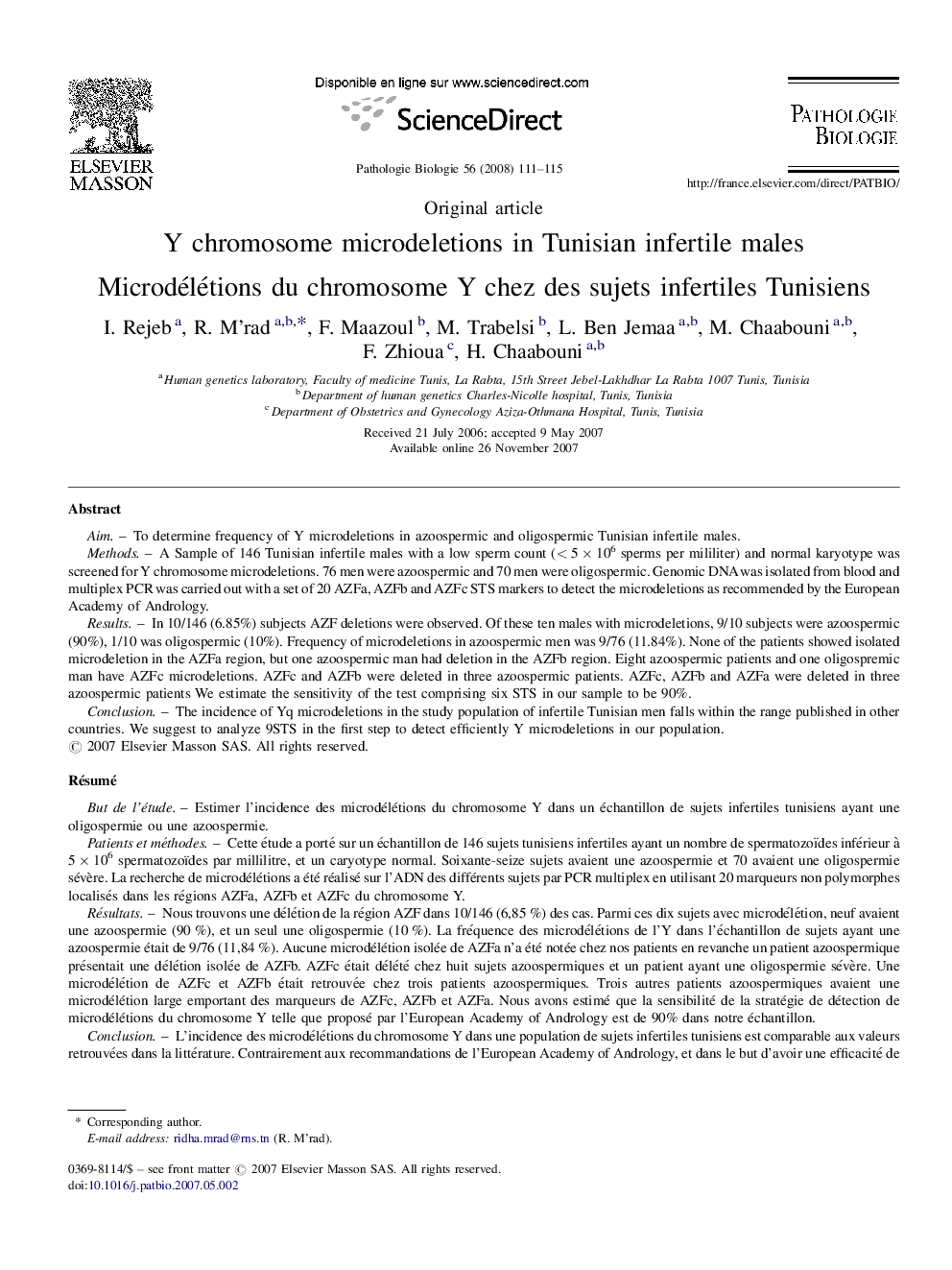| کد مقاله | کد نشریه | سال انتشار | مقاله انگلیسی | نسخه تمام متن |
|---|---|---|---|---|
| 4136742 | 1271936 | 2008 | 5 صفحه PDF | دانلود رایگان |

AimTo determine frequency of Y microdeletions in azoospermic and oligospermic Tunisian infertile males.MethodsA Sample of 146 Tunisian infertile males with a low sperm count (< 5 × 106 sperms per mililiter) and normal karyotype was screened for Y chromosome microdeletions. 76 men were azoospermic and 70 men were oligospermic. Genomic DNA was isolated from blood and multiplex PCR was carried out with a set of 20 AZFa, AZFb and AZFc STS markers to detect the microdeletions as recommended by the European Academy of Andrology.ResultsIn 10/146 (6.85%) subjects AZF deletions were observed. Of these ten males with microdeletions, 9/10 subjects were azoospermic (90%), 1/10 was oligospermic (10%). Frequency of microdeletions in azoospermic men was 9/76 (11.84%). None of the patients showed isolated microdeletion in the AZFa region, but one azoospermic man had deletion in the AZFb region. Eight azoospermic patients and one oligospremic man have AZFc microdeletions. AZFc and AZFb were deleted in three azoospermic patients. AZFc, AZFb and AZFa were deleted in three azoospermic patients We estimate the sensitivity of the test comprising six STS in our sample to be 90%.ConclusionThe incidence of Yq microdeletions in the study population of infertile Tunisian men falls within the range published in other countries. We suggest to analyze 9STS in the first step to detect efficiently Y microdeletions in our population.
RésuméBut de l’étudeEstimer l’incidence des microdélétions du chromosome Y dans un échantillon de sujets infertiles tunisiens ayant une oligospermie ou une azoospermie.Patients et méthodesCette étude a porté sur un échantillon de 146 sujets tunisiens infertiles ayant un nombre de spermatozoïdes inférieur à 5 × 106 spermatozoïdes par millilitre, et un caryotype normal. Soixante-seize sujets avaient une azoospermie et 70 avaient une oligospermie sévère. La recherche de microdélétions a été réalisé sur l’ADN des différents sujets par PCR multiplex en utilisant 20 marqueurs non polymorphes localisés dans les régions AZFa, AZFb et AZFc du chromosome Y.RésultatsNous trouvons une délétion de la région AZF dans 10/146 (6,85 %) des cas. Parmi ces dix sujets avec microdélétion, neuf avaient une azoospermie (90 %), et un seul une oligospermie (10 %). La fréquence des microdélétions de l’Y dans l’échantillon de sujets ayant une azoospermie était de 9/76 (11,84 %). Aucune microdélétion isolée de AZFa n’a été notée chez nos patients en revanche un patient azoospermique présentait une délétion isolée de AZFb. AZFc était délété chez huit sujets azoospermiques et un patient ayant une oligospermie sévère. Une microdélétion de AZFc et AZFb était retrouvée chez trois patients azoospermiques. Trois autres patients azoospermiques avaient une microdélétion large emportant des marqueurs de AZFc, AZFb et AZFa. Nous avons estimé que la sensibilité de la stratégie de détection de microdélétions du chromosome Y telle que proposé par l’European Academy of Andrology est de 90% dans notre échantillon.ConclusionL’incidence des microdélétions du chromosome Y dans une population de sujets infertiles tunisiens est comparable aux valeurs retrouvées dans la littérature. Contrairement aux recommandations de l’European Academy of Andrology, et dans le but d’avoir une efficacité de détection maximale dans notre population, nous proposons d’étudier dans un premier temps neuf marqueurs des différentes régions AZF du chromosome Y.
Journal: Pathologie Biologie - Volume 56, Issue 3, May 2008, Pages 111–115